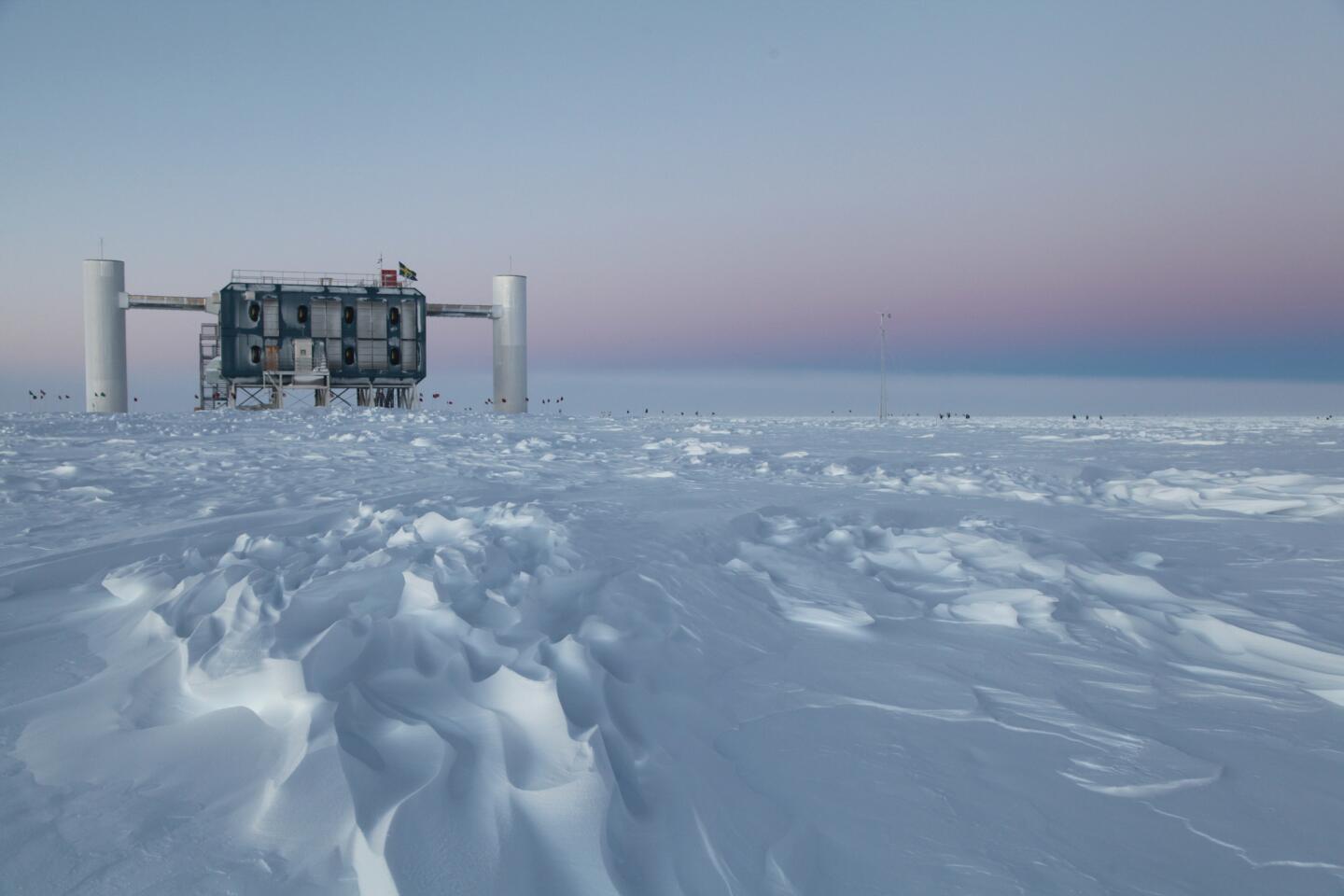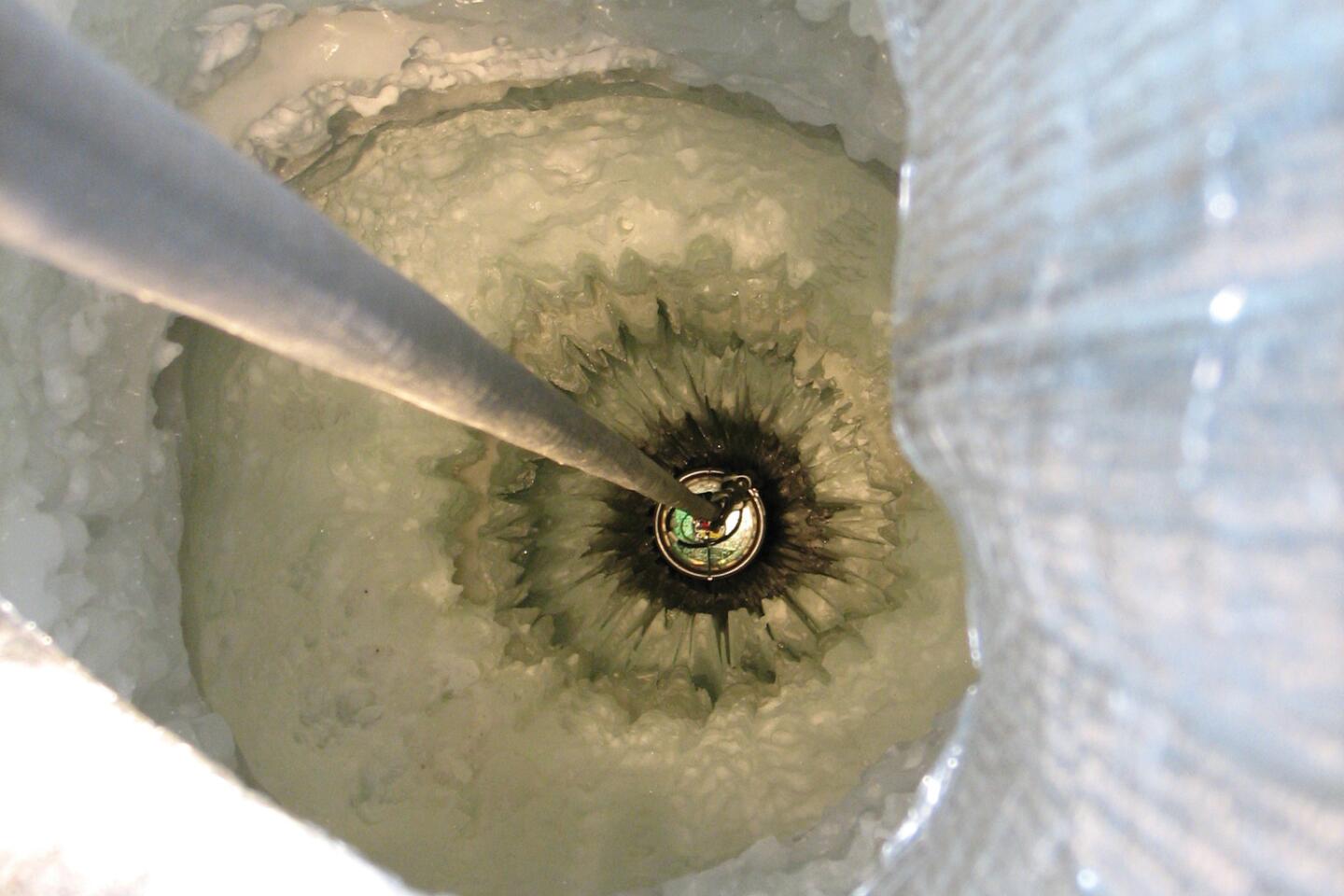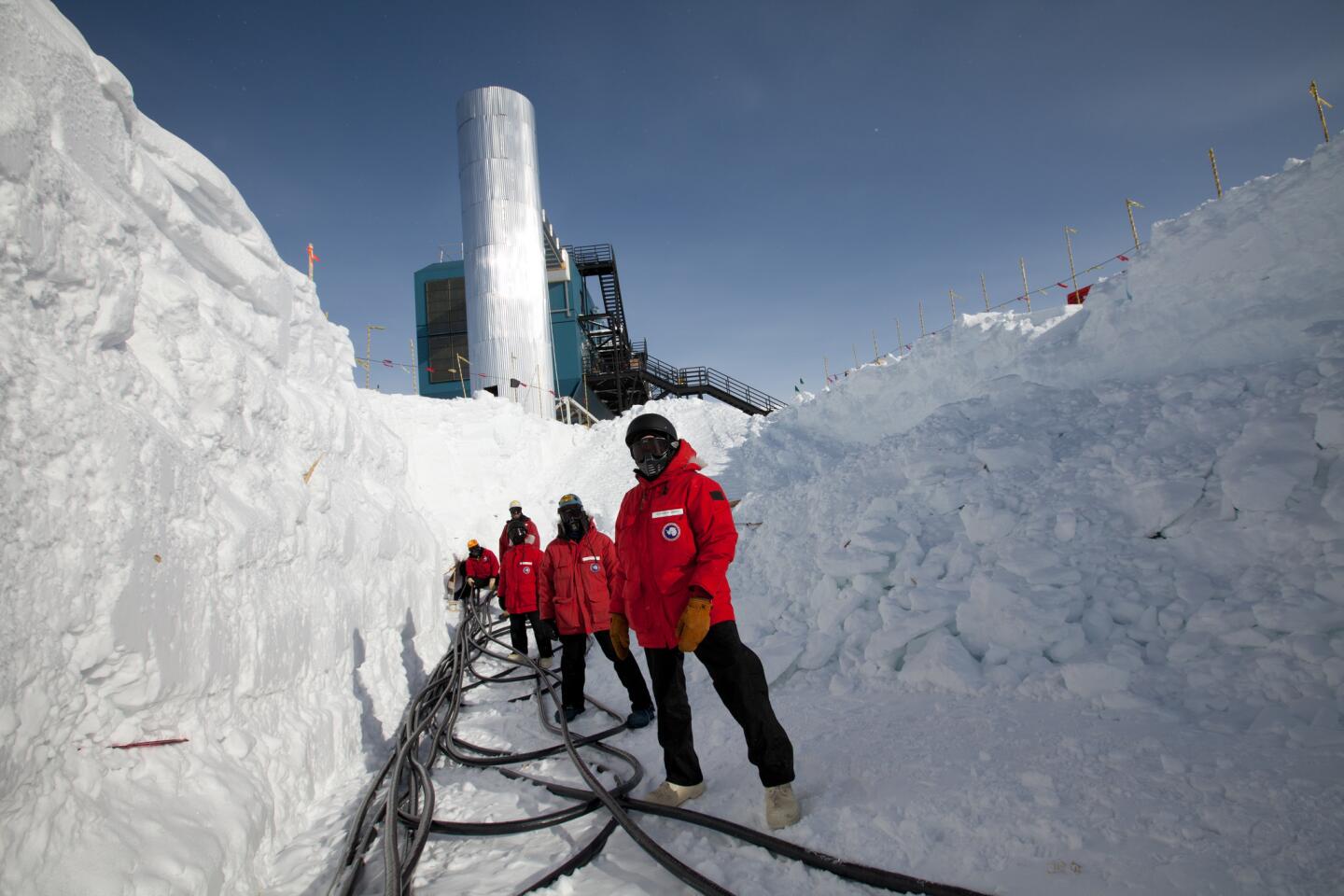Rare tiny neutrinos may have huge implications for astronomy
- Share via
Together, they contain a tiny fraction of the mass of a single electron. But the 28 neutrinos from deep space detected by an icy observatory beneath the South Pole promise a revolution in the study of the universe, scientists said Thursday.
The elusive subatomic particles discovered by an international team of astrophysicists are the first ones from outside the solar system to be observed in 26 years, according to a report in the journal Science. The find opens a new window onto the universe, one that researchers say will usher in a new era of astronomy.
The neutrinos identified by the IceCube team are roughly a billion times as energetic as the solar neutrinos streaming out of the sun’s nuclear furnace. Whatever created them must have been extremely powerful, utterly mysterious, or both.
“This is a landmark discovery — possibly a Nobel Prize in the making,” said Alexander Kusenko, a UCLA astroparticle physicist who was not involved in the IceCube collaboration.
Neutrinos are incredibly light, with almost no mass. The universe is filled with them, and billions pass unharmed through your finger every second.
PHOTOS: How to find neutrinos in underground ice
Theorized in 1930 and detected in 1956, neutrinos forced scientists to rewrite the laws of particle physics. They can spontaneously switch among what particle physicists refer to as three different “flavors”: electron neutrino, muon neutrino and tau neutrino. Each flavor has a different mass.
Neutrinos are created in enormous blasts when something gigantic explodes. Astrophysicists hope the minuscule particles will help them figure out where mysterious streams of high-energy particles called cosmic rays are coming from. They also wonder whether dark matter — that hypothesized stuff that we can’t see or touch but that makes up more than one-quarter of the universe — might emit neutrinos that they could detect. So might other yet-undiscovered phenomena in the universe.
“The goal is to try to make a map of the sky in a totally different way,” said Francis Halzen, a physicist at the University of Wisconsin-Madison and lead scientist for the IceCube collaboration. “Each time someone has done that, they have found something new.”
Until now, astronomers have observed aspects of the universe that show up on the electromagnetic spectrum. They started with visible light. Every time they have looked beyond those wavelengths, it has opened up a new way to view the universe.
For example, radio waves — the longest waves on the spectrum — led to the discovery of the cosmic microwave background radiation that’s a remnant of the big bang. X-rays — which are shorter than visible light — revealed black holes, neutron stars and other extremely powerful celestial objects. There are also telescopes tuned to the microwave, infrared, ultraviolet and gamma ray portions of the electromagnetic spectrum.
All of these depend on light, which can be blocked by clouds, planets or galaxies. Not so with neutrinos: Since they hardly interact with matter, they can pass by undeterred.
And since neutrinos lack positive or negative charge, they aren’t bent or warped by magnetic fields. If a neutrino hits you, you can figure out exactly where it came from. That’s why scientists like Halzen are so eager to build telescopes to detect them.
“There’s nothing that stops a neutrino,” Halzen said.
Here’s the problem: These valuable standoffish qualities also make neutrinos devilishly difficult to detect. On top of that, they’re created all the time as cosmic rays hit the atmosphere and produce showers of high-energy subatomic particles that generate distracting background noise.
Neutrino detectors block out most of the background noise by using Earth’s bulk to filter out muons and other secondary cosmic rays. They’re typically built underground or underwater.
But the IceCube team wanted to make a big detector: More real estate would mean a larger collecting area and raise researchers’ chances of collecting the neutrinos they wanted. They identified a cubic kilometer of pure, clear Antarctic ice, which is an ideal medium for detecting neutrinos because eons of compression have pushed out all the air bubbles.
It took seven years for the IceCube team to complete the detector. To do so, they had to drill narrow holes in the pristine ice and lower 86 strings containing 60 digital detectors each. When a neutrino makes contact with the ice — only one in a million neutrinos do, Halzen said — it produces a flash of blue light that the network of 5,160 detectors picks up.
The last challenge was to figure out a way to find the rare extraterrestrial neutrinos amid the haystack of atmospheric neutrinos. Luckily, there is one key difference between local and long-distance neutrinos: Those made in Earth’s atmosphere travel with companion muons, while alien neutrinos ride solo, without a particle entourage.
When atmospheric neutrinos shoot through Earth, they are stripped of their muons, which makes them look a lot like interstellar neutrinos. So the IceCube scientists turned their focus straight out at the southern heavens. That way, the atmospheric neutrinos would be recognizable because they’d still have their muons.
“That has turned a lot of the regular scheme of how you do neutrino astronomy on its head,” said Nathan Whitehorn, a University of Wisconsin-Madison astrophysicist and one of the study’s lead authors.
In addition, alien neutrinos typically have higher energies than atmospheric neutrinos, and that helped the scientists identify the interstellar visitors.
After sifting through about 200,000 neutrino hits recorded over two years, the scientists found 28 that they say could not have come from anywhere but outside the solar system. These neutrinos came from all over the sky, not from any particular location.
But 28 is a small sample, Halzen acknowledged. The hope, he said, is to create a whole map of the universe, sketched out in neutrinos — and see what turns up.
The neutrino find is far more exciting than last year’s discovery of the Higgs boson, another long-awaited event that took the physics community by storm, said John Learned, a neutrino physicist at the University of Hawaii at Manoa.
Finding the Higgs was “a great triumph,” he said, but “we didn’t learn anything we didn’t already know.”








